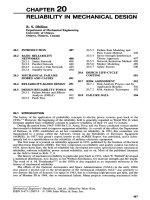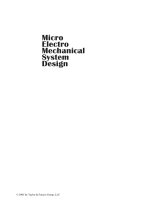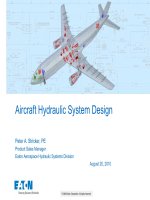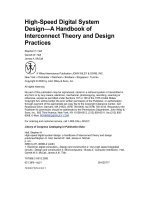Aircraft Hydraulic System Design pptx
Bạn đang xem bản rút gọn của tài liệu. Xem và tải ngay bản đầy đủ của tài liệu tại đây (1.86 MB, 27 trang )
©
2008 Eaton Corporation. All rights reserved.
Aircraft Hydraulic System Design
Peter A. Stricker, PE
Product Sales Manager
Eaton Aerospace Hydraulic Systems Division
August 20, 2010
2
Purpose
•
Acquaint participants with hydraulic system
design principles for civil aircraft
•
Review examples of hydraulic system
architectures on common aircraft
3
Agenda
•
Introduction
•
Review of Aircraft Motion Controls
•
Uses for and sources of hydraulic power
•
Key hydraulic system design drivers
•
Safety standards for system design
•
Hydraulic design philosophies for conventional, “more
electric” and “all electric” architectures
•
Hydraulic System Interfaces
•
Sample aircraft hydraulic system block diagrams
•
Conclusions
4
Introduction
As airplanes grow in size, so
do the forces needed to move the
flight controls … thus the need to
transmit larger amount of power
Ram Air
Turbine Pump
Hydraulic
Storage/Conditioning
Engine
Pump
Electric
Generator
Electric
Motorpump
Flight Control
Actuators
Air Turbine
Pump
Hydraulic system
transmits and controls
power from engine to
flight control actuators
2
Pilot inputs are
transmitted to remote
actuators and amplified
1
3
Pilot commands move
actuators with little effort
4
Hydraulic power is
generated mechanically,
electrically and
pneumatically
5
Pilot Inputs
5
Introduction
•
Aircraft’s Maximum Take-Off Weight (MTOW) drives
aerodynamic forces that drive control surface size and loading
•
A380 – 1.25 million lb MTOW – extensive use of hydraulics
•
Cessna 172 – 2500 lb MTOW – no hydraulics – all manual
6
Controlling Aircraft Motion
Primary Flight Controls
Definition of Airplane Axes
1 Ailerons control roll
2 Elevators control pitch
3 Rudder controls yaw
1
3 2
7
Controlling Aircraft Motion
Secondary Flight Controls
High Lift Devices:
►
•
Flaps (Trailing Edge), slats (LE Flaps)
increase area and camber of wing
•
permit low speed flight
Flight Spoilers / Speed Brakes: permit steeper
descent and augment ailerons at low speed
when deployed on only one wing
Ground Spoilers: Enhance deceleration on
ground (not deployed in flight)
Trim Controls:
•
Stabilizer (pitch), roll and rudder (yaw) trim to
balance controls for desired flight condition
8
Example of Flight Controls (A320)
REF: A320 FLIGHT CREW OPERATING MANUAL
CHAPTER 1.27 - FLIGHT CONTROLS
PRIMARY
SECONDARY
9
Why use Hydraulics?
•
Effective and efficient method of power amplification
•
Small control effort results in a large power output
•
Precise control of load rate, position and magnitude
•
Infinitely variable rotary or linear motion control
•
Adjustable limits / reversible direction / fast response
•
Ability to handle multiple loads simultaneously
•
Independently in parallel or sequenced in series
•
Smooth, vibration free power output
•
Little impact from load variation
•
Hydraulic fluid transmission medium
•
Removes heat generated by internal losses
•
Serves as lubricant to increase component life
10
HYDR. MOTOR
TORQUE TUBE
GEARBOX
Typical Users of Hydraulic Power
•
Landing gear
•
Extension, retraction, locking, steering, braking
•
Primary flight controls
•
Rudder, elevator, aileron, active (multi-function)
spoiler
•
Secondary flight controls
•
high lift (flap / slat), horizontal stabilizer, spoiler, thrust
reverser
•
Utility systems
•
Cargo handling, doors, ramps, emergency electrical
power generation
Flap DriveSpoiler Actuator
Landing Gear
Nosewheel Steering
11
Sources of Hydraulic Power
Ram Air Turbine
AC Electric Motorpump
Maintenance-free
Accumulator
Engine Driven Pump
•
Mechanical
•
Engine Driven Pump (EDP) - primary hydraulic power source,
mounted directly to engines on special gearbox pads
•
Power Transfer Unit – mechanically transfers hydraulic
power between systems
•
Electrical
•
Pump attached to electric motors, either AC or DC
•
Generally used as backup or as auxiliary power
•
Electric driven powerpack used for powering actuation zones
•
Used for ground check-out or actuating doors when
engines are not running
Pneumatic
•
Bleed Air turbine driven pump used for backup power
•
Ram Air Turbine driven pump deployed when all engines
are inoperative and uses ram air to drive the pump
•
Accumulator provides high transient power by releasing
stored energy, also used for emergency and parking brake
Power Transfer Unit
12
Key Hydraulic System Design Drivers
•
High Level certification requirement per aviation
regulations:
Maintain control of the aircraft under all normal and
anticipated failure conditions
•
Many system architectures* and design approaches
exist to meet this high level requirement – aircraft
designer has to certify to airworthiness regulators by
analysis and test that his solution meets requirements
*
Hydraulic System Architecture:
Arrangement and interconnection of hydraulic power sources
and consumers in a manner that meets requirements for
controllability of aircraft
13
Considerations for Hydraulic System Design
to meet System Safety Requirements
•
Redundancy in case of failures must be
designed into system
•
Any and every component will fail during life of
aircraft
•
Manual control system requires less
redundancy
Fly-by-wire (FBW) requires more redundancy
•
Level of redundancy necessary evaluated per
methodology described in ARP4761
•
Safety Assessment Tools
•
Failure Modes, Effects and Criticality Analysis –
computes failure rates and failure criticalities of
individual components and systems by
considering all failure modes
•
Fault Tree Analysis – computes failure rates
and probabilities of various combinations of
failure modes
•
Markov Analysis – computes failure rates and
criticality of various chains of events
•
Common Cause Analysis – evaluates failures
that can impact multiple components and
systems
•
Principal failure modes considered
•
Single system or component failure
•
Multiple system or component failures occurring
simultaneously
•
Dormant failures of components or subsystems
that only operate in emergencies
•
Common mode failures – single failures that
can impact multiple systems
•
Examples of failure cases to be considered
•
One engine shuts down during take-off – need
to retract landing gear rapidly
•
Engine rotor bursts – damage to and loss of
multiple hydraulic systems
•
Rejected take-off – deploy thrust reversers,
spoilers and brakes rapidly
•
All engines fail in flight – need to land safely
without main hydraulic and electric power
sources
14
Civil Aircraft System Safety Standards
(Applies to all aircraft systems)
Failure
Criticality Failure Characteristics
Probability of
Occurrence
Design
Standard
Minor
Normal, nuisance and/or possibly requiring
emergency procedures
Reasonably
probable
NA
Major
Reduction in safety margin, increased crew
workload, may result in some injuries
Remote
P ≤ 10
-5
Hazardous
Extreme reduction in safety margin, extended
crew workload, major damage to aircraft and
possible injury and deaths
Extremely remote
P ≤ 10
-7
Catastrophic
Loss of aircraft with multiple deaths Extremely
improbable
P ≤ 10
-9
Examples
Minor: Single hydraulic system fails
Major: Two (out of 3) hydraulic systems fail
Hazardous: All hydraulic sources fail, except RAT or APU
(US1549 Hudson River A320 – 2009)
Catastrophic: All hydraulic systems fail
(UA232 DC-10 Sioux City – 1989)
15
System Design Philosophy
Conventional Central System Architecture
•
Multiple independent centralized power
systems
•
Each engine drives dedicated pump(s),
augmented by independently powered
pumps – electric, pneumatic
•
No fluid transfer between systems to
maintain integrity
•
System segregation
•
Route lines and locate components far
apart to prevent single rotor or tire burst
from impacting multiple systems
•
Multiple control channels for critical
functions
•
Each flight control needs multiple
independent actuators or control
surfaces
•
Fail-safe failure modes – e.g., landing
gear can extend by gravity and be
locked down mechanically
LEFT ENG.
SYSTEM 1
SYSTEM 3 RIGHT ENG.
SYSTEM 2
EDP EDP
ROLL 1
PITCH 1
YAW 1
OTHERS
EMP
EMP RAT
PTU
ROLL 2
PITCH 2
YAW 2
OTHERS
EMP
ROLL 3
PITCH 3
YAW 3
LNDG GR
EMRG BRK
NORM BRK
NSWL STRG
ADP
EDP Engine Driven Pump
EMP Electric Motor Pump
ADP Air Driven Pump
PTU Power Transfer Unit
RAT Ram Air Turbine
Engine Bleed Air
OTHERS
16
System Design Philosophy
More Electric Architecture
•
Two independent centralized power
systems + Zonal & Dedicated
Actuators
•
Each engine drives dedicated pump(s),
augmented by independently powered
pumps – electric, pneumatic
•
No fluid transfer between systems to
maintain integrity
•
System segregation
•
Route lines and locate components far
apart to prevent single rotor or tire burst
to impact multiple systems
•
Third System replaced by one or more
local and dedicated electric systems
•
Tail zonal system for pitch, yaw
•
Aileron actuators for roll
•
Electric driven hydraulic powerpack for
emergency landing gear and brake
•
Examples: Airbus A380, Boeing 787
LEFT ENG.
SYSTEM 1
RIGHT ENG.
SYSTEM 2
EDP EDP
ROLL 1
PITCH 1
YAW 1
OTHERS
EMP
GEN1 RAT
ROLL 2
PITCH 2
YAW 2
OTHERS
EMP
ROLL 3
ZONAL
PITCH 3 YAW
3
NORM BRK
EMRG BRKLNDG GR
NW STRG
GEN2
EDP Engine Driven Pump
EMP Electric Motor Pump
GEN Electric Generator
RAT Ram Air Turbine Generator
Electric Channel
OTHERS
ELECTRICAL
ACTUATORS
LG / BRK
EMERG
POWER
17
System Design Philosophy
All Electric Architecture
“Holy Grail” of aircraft power distribution ….
•
Relies on future engine-core mounted electric generators
capable of high power / high power density generation,
running at engine speed – typically 40,000 rpm
•
Electric power will replace all hydraulic and pneumatic power
for all flight controls, environmental controls, de-icing, etc.
•
Flight control actuators will like remain hydraulic, using
Electro-Hydrostatic Actuators (EHA) or local hydraulic
systems, consisting of
•
Miniature, electrically driven, integrated hydraulic power
generation system
•
Hydraulic actuator controlled by electrical input
18
Fly-by-Wire (FBW) Systems
Fly-by-Wire
•
Pilot input read by computers
•
Computer provides input to electrohydraulic flight
control actuator
•
Control laws include
•
Enhanced logic to automate many functions
•
Artificial damping and stability
•
Flight Envelope Protection to prevent airframe from
exceeding structural limits
•
Multiple computers and actuators provide sufficient
redundancy – no manual reversion
Conventional Mechanical
•
Pilot input mechanically connected to flight control
hydraulic servo-actuator by cables, linkages,
bellcranks, etc.
•
Servo-actuator follows pilot command with high
force output
•
Autopilot input mechanically summed
•
Manual reversion in case of loss of hydraulics or
autopilot malfunction
BOEING 757 AILERON SYSTEM
PILOT INPUTS
AUTOPILOT INPUTS
LEFT WING
RIGHT WING
19
Principal System Interfaces
Design Considerations
Hydraulic System
Hydraulic power from EDP
Nacelle / Engine
Pad speed as a function of
flight regime – idle to take-off
Landing Gear
Power on Demand
Flow under normal and all
emergency conditions –
retract / extend / steer
Electric motors, Solenoids
Electrical System
Electrical power variations
under normal and all
emergency conditions
(MIL-STD-704)
Flight Controls
Power on Demand
Flow under normal and
all emergency conditions
– priority flow when LG,
flaps are also
demanding flow
Avionics
Signals from pressure,
temperature, fluid quantity sensors
Signal to solenoids, electric motors
20
Aircraft Hydraulic Architectures
Comparative Aircraft Weights
Increasing Hydraulic System Complexity
21
Aircraft Hydraulic Architectures
Example Block Diagrams – Learjet 40/45
MAIN SYSTEM
EMERGENCY SYSTEM
MTOW: 21,750 lb
Flight Controls: Manual
Key Features
•
One main system fed by 2 EDP’s
•
Emergency system fed by DC electric pump
•
Common partitioned reservoir (air/oil)
•
Selector valve allows flaps, landing gear,
nosewheel steering to operate from main or
emergency system
•
All primary flight controls are manual
Safety / Redundancy
•
Engine-out take-off: One EDP has sufficient power
to retract gear
•
All Power-out: Manual flight controls; LG extends by
gravity with electric pump assist; emergency flap
extends by electric pump; Emergency brake energy
stored in accumulator for safe stopping
REF.: AIR5005A (SAE)
Mid-Size Jet
22
Aircraft Hydraulic Architectures
Example Block Diagrams – Hawker 4000
MTOW: 39,500 lb
Flight Controls: Hydraulic with manual reversion
exc. Rudder, which is Fly-by-Wire (FBW)
Key Features
•
Two independent systems
•
Bi-directional PTU to transfer power between
systems without transferring fluid
•
Electrically powered hydraulic power-pack for
Emergency Rudder System (ERS)
Safety / Redundancy
•
All primary flight controls 2-channel; rudder has
additional backup powerpack; others manual
reversion
•
Engine-out take-off: PTU transfers power from
system #1 to #2 to retract LG
•
Rotorburst: Emergency Rudder System is located
outside burst area
•
All Power-out: ERS runs off battery; others manual;
LG extends by gravity
Super Mid Size
REF.: EATON C5-38A 04/2003
23
Aircraft Hydraulic Architectures
Example Block Diagrams – Airbus A320/321
MTOW (A321): 206,000 lb
Flight Controls: Hydraulic FBW
Key Features
•
3 independent systems
•
2 main systems with EDP
1 main system also includes backup EMP &
hand pump for cargo door
3
rd
system has EMP and RAT pump
•
Bi-directional PTU to transfer power between
primary systems without transferring fluid
Safety / Redundancy
•
All primary flight controls have 3 independent
channels
•
Engine-out take-off: PTU transfers power from
Y to G system to retract LG
•
Rotorburst: Three systems sufficiently
segregated
•
All Power-out: RAT pump powers Blue; LG
extends by gravity
Single-Aisle
REF.: AIR5005 (SAE)
24
Aircraft Hydraulic Architectures
Example Block Diagrams – Boeing 777
LEFT SYSTEM
Wide Body
RIGHT SYSTEMCENTER SYSTEM
MTOW (B777-300ER): 660,000 lb
Flight Controls: Hydraulic FBW
Key Features
•
3 independent systems
•
2 main systems with EDP + EMP each
•
3
rd
system with 2 EMPs, 2 engine bleed air-
driven (engine bleed air) pumps, + RAT pump
Safety / Redundancy
•
All primary flight controls have 3 independent
channels
•
Engine-out take-off: One air driven pump and
EMP available in system 3 to retract LG
•
Rotorburst: Three systems sufficiently
segregated
•
All Power-out: RAT pump powers center
system; LG extends by gravity
REF.: AIR5005 (SAE)
25
Aircraft Hydraulic Architectures
Example Block Diagrams – Airbus A380
Wide Body
MTOW: 1,250,000 lb
Flight Controls: FBW (2H + 1E channel)
Key Features / Redundancies
•
Two independent hydraulic systems
+ one electric system (backup)
•
Primary hydraulic power supplied by 4
EDP’s per system
•
All primary flight controls have 3 channels
– 2 hydraulic + 1 electric
•
4 engines provide sufficient redundancy
for engine-out cases
REF.: EATON C5-37A 06/2006









